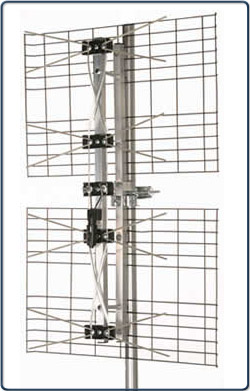And just why would you want to go back to the old days and connect to an outdoor antenna? It just may give you better picture quality on your high-definition (HD) television. More and more local television channels are broadcasting in HD. But you say you already have cable or satellite. Great! The problem might be that the satellite provider or the cable TV company may compress the signal before sending it to you, giving you a poorer picture. And they may charge an additional fee for local channels. An outside antenna with the right technology will give you local HD broadcasts that are not compressed and it is free.
You may not really care about HD television. You may be perfectly happy with analog (old fashion) broadcasts on your current TV. It won’t be long and you won’t have a choice. The United States government is requiring all broadcasters to switch to digital by February 2009. That isn’t all that many page turns on the calendar.
The pictures you get, or will get on an HD television with an antenna will be great. If you aren’t aware of digital technology, you don’t get a weak, fuzzy or snowy signal. You either get a flawless signal or none at all, just a black screen. There would be no snow like you sometimes got years ago from your old antenna and analog signals.
So if you get either a perfect picture or no picture, why not just use rabbit ears? Good question. You can. Rabbit ears, or other inside antennae, tend to work just fine…if you are within 25 miles of the local station’s broadcast facility. Typically you should expect an outside antenna to capture signals from about 70 miles away, depending on what is in between you and the broadcast tower. Mountains and prisons are two great signal blockers, for example.
You may be wondering how an outside antenna can possible give you a better quality than cable, if you are like many others. We think that way, or we wouldn’t have joined up with cable or satellite in the first place. Your cable or satellite provider needs to provide you with many HD channels or choices. They have to make sure there is room for all of those choices. To make sure there is room they sometimes compress, or remove, a certain amount of data from the signal you end up with at your television. Your local HD broadcaster doesn’t care about providing space for other broadcasters. In fact, they would be perfectly happy if you simply watched their station only. There is no data removed, no signal compression.
If you are an ESPN, CNN, History Channel, Disney Channel, or Weather Channel junkie, you won’t be capturing them with just an antenna, inside or out. You can add an antenna as a signal source to your cable or satellite system and, for a small price, enjoy the ultimate your local broadcasters have to offer, along with the other channels you are addicted to.
If you decide you want to try either an indoor or outdoor antenna for HDTV, they range in price from about $20 to $170. You can also try making your own. It isn’t that difficult and would save you even more money.
No matter if you are interested in HDTV or not, the time is coming when you won’t have a choice. An antenna may be your answer. Even if it isn’t, they are cheap enough or easy enough to make yourself that you can test the performance out before you make a final decision.
Once again, what is old is made new.
Michael Russell Your Independent guide to Antennas
Article Source: http://EzineArticles.com/?expert=Michael_Russell
The New Old-Fashioned Antenna
Labels: hdtv antenna
